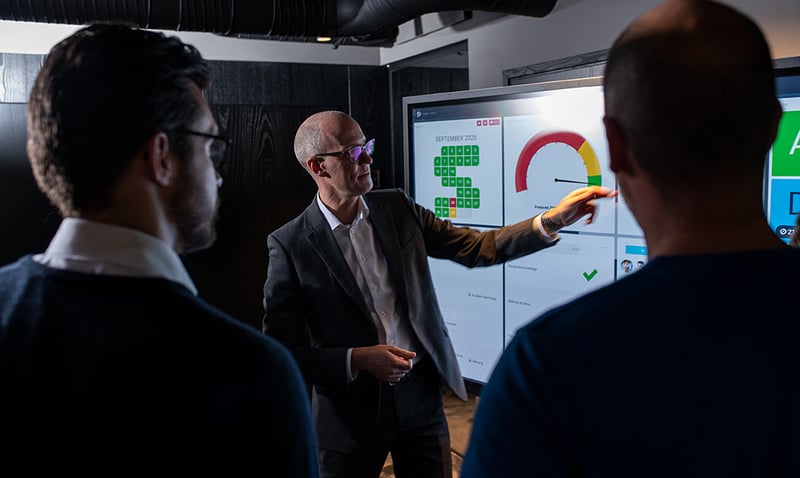Get started with Mevisio
Getting started with Mevisio isn’t difficult, but there are a few things to keep in mind to make sure everything goes smooth at startup.
A few introductory tips: involve the entire company in the implementation phase. Inform staff about why you’ve chosen Mevisio and the expected rollout timeline. That way, you can maximize employee engagement and help them understand the boards. It’s also a good idea to start on a smaller scale and then slowly expand from there until the entire organization has adopted the platform. That will make it easier to evaluate the results and shorten the startup phase. We also recommend that you clearly communicate your goals with the boards – clear goals make it easy to measure results.
The process
A normal implementation process is divided into seven steps and tends to take anywhere from one to three months.
- Startup: As a first step, we’ll put together a workshop to go through what you need to know and what you can expect from the boards.
- Demo boards: In this second step, you’ll get a chance to test out some of our pre-configured demo boards.
- First draft of your board: In step three we will walk through the first draft of your board’s design, testing out what works and what needs to be developed further.
- Go Live! We’re finally ready to start using the boards. This is an excellent opportunity for you to test out how the boards work in your day-to-day business and collect feedback from users.
- Integration: After testing out the boards, it’s time to integrate them with your current systems. This integration will, for example, automatically populate the boards’ diagrams and charts with data from your business system.
- Information channels: Step six will be dedicated to setting up the structure of the boards, adding various teams and chains of command to the boards, and creating channels for escalating issues, delegating tasks, and compiling information.
- Delivery: By the seventh and final step, the boards will be finished and ready to be delivered to you. At this stage, we recommend training sessions so that you are able to create boards and information channels on your own.
The boards’ designs will vary from screen to screen but answering the following questions will ensure that the design process goes as smoothly as possible.
What information will be shown on your screen?
Firstly you need to decide what kinds of information you want shown on the boards. Typically, this is safety issues, accidents, improvement suggestions, and production data. An easier question may be: what information do you need in order to have a productive morning meeting? Mevisio can be integrated with other systems, but it’s important to consider the following questions: What system are you currently using? What information do you want from that system? How do you want that information to be presented in Mevisio? And how often do you want the information on the screens to update?
How will the information be visualized?
It’s time to decide how you want the information presented on your screens. Mevisio offers many different presentation styles, such as charts, tables, and sticky notes - well as over 30 different modules, all of which are fully customizable. Effective visual management stimulates engagement and drives development forward, so think about what functions you would like, and we'll take care of the rest.
What will the layout look like?
The next step is to think about the layout. It can be a good idea for the “Team Boards” to focus on production, while the “Manager Boards” focus on presenting information clearly. Once you’ve decided on the layout, we’ll put it all together based on your decisions.
How will information be shared between screens?
You must decide how you want information to be shared between various screens. For example, you can divide the information horizontally between teams or vertically between seniority levels in your organization. Do managers have to delegate jobs to teams or do teams and managers need a way to efficiently communicate with each other? How information is shared also lets managers track teams' work to see what's going well and what needs to be improved.
Who has access to what?
Not all users need access to all the information, which is why we have created a keys and locks system. Every group gets a certain combination of keys, and every board is assigned a certain combination of locks. As such, it’s important to choose which groups have access to which keys.
Final tips
Think long-term, Mevisio is a scalable system for the future that can be configured in tandem with your business’s growth and development. For the best possible results, we recommend a flexible approach and close communication with us or any of our partners. Together we’ll establish a strong foundation to turn your business digital. We also offer training workshops where you can learn how to change the design on your personal screen.

